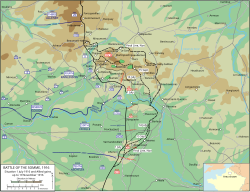| Attacks on High Wood | |||||||
|---|---|---|---|---|---|---|---|
| Part of the Battle of the Somme during the First World War | |||||||
 Relief map of the Somme battlefield, 1916 | |||||||
| |||||||
| Belligerents | |||||||
|
|
| ||||||
| Commanders and leaders | |||||||
|
Douglas Haig Henry Rawlinson |
Crown Prince Rupprecht of Bavaria Fritz von Below | ||||||
| Strength | |||||||
| Parts of 5 divisions | Parts of 8 divisions | ||||||
| Casualties and losses | |||||||
| 13,111 (High Wood and vicinity) | 9,498 (High Wood and vicinity: incomplete) | ||||||
The Attacks on High Wood, near Bazentin le Petit in the Somme département of northern France, took place between the British Fourth Army and the German 1st Army during the Battle of the Somme. After the Battle of Bazentin Ridge on 14 July 1916, High Wood lay undefended for most of the day but delays in communication and confusion caused by orders and counter-orders from British corps headquarters, which had overlapping responsibilities, led to the occupation of High Wood being forestalled by German reserves, which had moved forward to counter-attack British troops in the villages of Bazentin-le-Grand and Bazentin-le-Petit.
Men from the 7th Division managed to occupy the southern half of the wood and two cavalry squadrons advanced on the east side to Wood Lane, which connected the wood to Longueval. On 15 July, the wood was evacuated by the survivors and the cavalry retired. The British and the Germans fought for control of the wood from 14 July to 15 September. Both sides had many casualties and chronic communication problems; inclement weather grounded aircraft, obscured the view and slowed movement on the roads, which had been severely bombarded and turned to mud as soon as it rained. Trenches and shell holes filled with water, which made infantry movement exceedingly difficult and exhausted trench garrisons. The British and French found it impossible to arrange co-ordinated attacks and fought many small piecemeal actions, rather than general attacks until 15 September.
British-French co-operation broke down again and the French did not attack on 15 September, when the British captured the wood during the Battle of Flers–Courcelette (15–22 September). The German defenders had great difficulty finding fresh troops for the Somme front, despite ending the Battle of Verdun (21 February – 20 December) and had to send divisions to the Eastern Front and to Romania after it declared war on 27 August. Turnover of German divisions was high and many had to be withdrawn and replaced after fourteen days in the front line. The Germans lacked the resources to make many big organised counter-attacks and those at High Wood and the vicinity were often as costly and ineffective as corresponding British attacks.
© MMXXIII Rich X Search. We shall prevail. All rights reserved. Rich X Search

